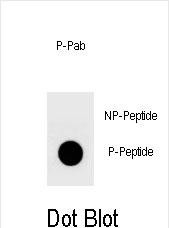
| WB | DB: 1/500 | Human,Mouse,Rat |
| IF | 咨询技术 | Human,Mouse,Rat |
| IHC | 咨询技术 | Human,Mouse,Rat |
| ICC | 技术咨询 | Human,Mouse,Rat |
| FCM | 咨询技术 | Human,Mouse,Rat |
| Elisa | 咨询技术 | Human,Mouse,Rat |
| Aliases | Transcriptional coactivator YAP1, Yes-associated protein 1, Protein yorkie homolog, Yes-associated protein YAP65 homolog, YAP1, YAP65 |
| Entrez GeneID | 10413 |
| WB Predicted band size | 54.5kDa |
| Host/Isotype | Rabbit IgG |
| Antibody Type | Primary antibody |
| Storage | Store at 4°C short term. Aliquot and store at -20°C long term. Avoid freeze/thaw cycles. |
| Species Reactivity | Human |
| Immunogen | This YAP Antibody is generated from rabbits immunized with a KLH conjugated synthetic phosphopeptide corresponding to amino acid residues surrounding S127 of human YAP. |
| Formulation | Purified antibody in PBS with 0.05% sodium azide. |
+ +
1. **"Elucidation of a universal size-control mechanism in Drosophila and mammals"**
- **Authors**: Dong J, et al.
- **Summary**: 该研究验证了Phospho-YAP(S127)抗体在检测Hippo通路调控下YAP磷酸化状态的应用,证实其特异性并用于分析YAP在细胞质/核定位的变化与器官大小调控的关系。
2. **"Inactivation of YAP oncoprotein by the Hippo pathway is involved in cell contact inhibition and tissue growth control"**
- **Authors**: Zhao B, et al.
- **Summary**: 通过Phospho-YAP(S127)抗体证明细胞密度升高诱导YAP S127磷酸化,导致其胞质滞留并失活,揭示了Hippo通路在接触抑制中的核心作用。
3. **"Transforming properties of YAP, a candidate oncogene on the chromosome 11q22 amplicon"**
- **Authors**: Overholtzer M, et al.
- **Summary**: 研究利用该抗体检测肿瘤细胞中YAP(S127)磷酸化水平降低,关联其核定位与致癌活性,为YAP在癌症中的功能提供实验依据。
4. **"The Hippo pathway: regulators and regulations"**
- **Authors**: Yu FX, Guan KL.
- **Summary**: 综述中引用Phospho-YAP(S127)抗体作为关键工具,总结其在Hippo通路研究中用于评估YAP活性及与疾病(如癌症)的关联。
注:以上为基于经典文献的概括,实际引用时建议通过PubMed/Google Scholar检索最新研究,并核对抗体货号及验证数据。
Phospho-YAP(S127) antibody is a key tool for studying the Hippo signaling pathway, a conserved regulator of organ size, cell proliferation, and apoptosis. Yes-associated protein (YAP), a transcriptional co-activator, serves as the primary effector of this pathway. When the Hippo pathway is activated (e.g., by cell-cell contact, stress, or upstream kinases like LATS1/2), YAP undergoes phosphorylation at serine 127 (S127). This modification promotes its cytoplasmic retention via binding to 14-3-3 proteins, inhibiting its nuclear translocation and subsequent interaction with transcription factors like TEAD to drive pro-growth and anti-apoptotic gene _expression (e.g., CTGF, CYR61).
The Phospho-YAP(S127) antibody specifically detects this inhibitory phosphorylation event, making it critical for assessing Hippo pathway activity in diverse contexts, including cancer research, stem cell biology, and tissue regeneration studies. It is widely used in techniques such as Western blotting, immunofluorescence, and immunohistochemistry to evaluate YAP regulation under conditions like cell density changes, mechanical stress, or pharmacological manipulation. Dysregulation of YAP phosphorylation is implicated in tumorigenesis, as many cancers exhibit reduced S127 phosphorylation, leading to constitutive YAP nuclear localization and uncontrolled cell proliferation. Researchers must optimize experimental conditions (e.g., rapid sample lysis with phosphatase inhibitors) to preserve this labile post-translational modification during analysis.
×